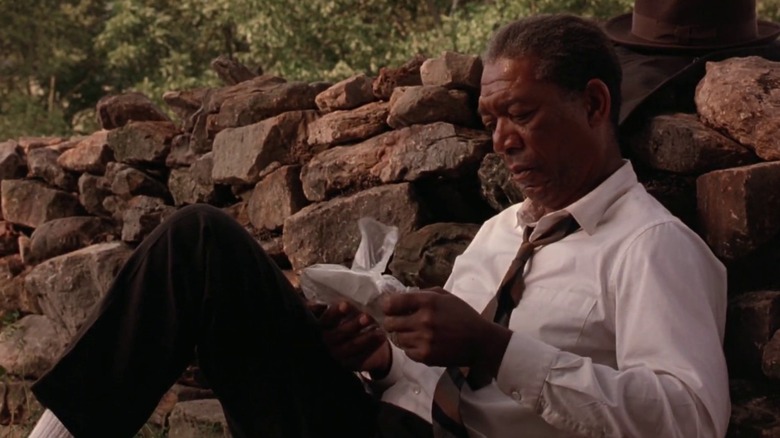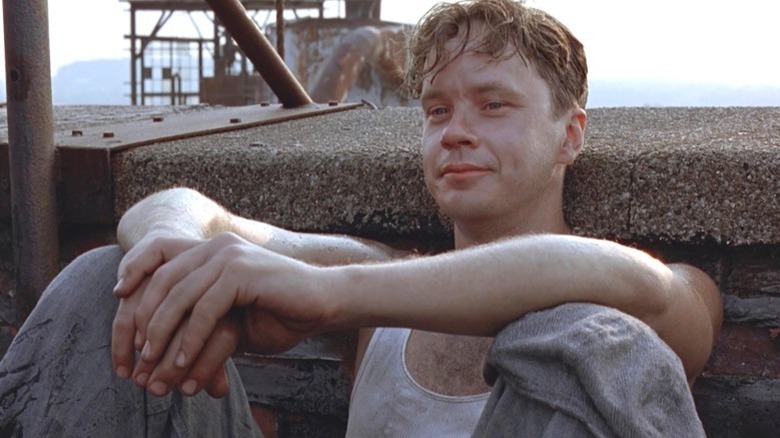Castle Rock Entertainment
The 1994 prison drama “The Shawshank Redemption,” directed by Frank Darabont and inspired by a Stephen King novella, is an example of a film that achieved success slowly, a phenomenon seemingly lost in today’s film industry. Despite its late September release and lack of initial buzz, “Shawshank” garnered generally favorable reviews, with critics lauding the central performances of Tim Robbins and Morgan Freeman, as well as the screenplay’s delicate touch. The film currently holds an impressive 89% approval rating on Rotten Tomatoes.
“Shawshank” received seven Academy Award nominations, but unfortunately, it didn’t win any, overshadowed by films like “Forrest Gump,” “Pulp Fiction,” “Quiz Show,” and Krzysztof Kieślowski’s “Red.” The film found its audience when it was released on VHS, with its popularity increasing exponentially. Some even regard it as one of the best films of the 1990s. By 1999, Roger Ebert included it on his list of Great Movies, and it continues to top IMDb’s list of the top 250 movies of all time. When it comes to classic Hollywood melodramas, “The Shawshank Redemption” is hard to beat.
In a 2019 retrospective on “Shawshank” by the New York Daily News, Freeman expressed admiration for the script (also penned by Darabont). He believed that each scene required expert handling to ensure the drama was perfectly conveyed. He recalled arguing with Darabont about a particular detail in a scene towards the film’s end (spoilers ahead), which involved a harmonica and which he refused to shoot. Fortunately, Darabont heeded his actor’s advice, and Freeman had his way.
The gift of the harmonica

Castle Rock Entertainment
“Shawshank” tells the story of a meek accountant, Andy Dufresne (Robbins), who is sent to Shawshank prison in 1947 for the murder of his wife, a crime he likely did not commit. The film follows Andy over the next two decades as he navigates the hardships and nuances of prison life, including assault from other inmates, the warden’s corruption, and the solace of a strong friendship. The film is narrated by Red (Freeman), Andy’s closest friend, who remarks on Andy’s unusual determination to cling to hope, a risky sentiment in a prison.
The film concludes with Andy making a dramatic escape from prison, and Red, having been granted parole, leaving Shawshank to join him. The final scene is an emotional reunion of the long-time friends on a Mexican beach, where they are both finally free after enduring years of oppression. According to Darabont’s original script, Red was supposed to play the harmonica to get Andy’s attention, prompting Andy to turn around and smile. Freeman was not a fan of this idea, stating:
“Frank thought I should be blowing that harmonica that Andy gave me. And I refused. [It was] sort of asinine, sort of cliched, sort of unnecessary and overkill.”
Although the harmonica was introduced earlier in the film, it was not a major element, and Red intentionally never learned to play it. Having him play the harmonica during the film’s final reunion scene would have indeed been asinine.
The long shoot

Castle Rock Entertainment
Robbins has vivid memories of the meticulous filming process. Shooting “The Shawshank Redemption” required three months of 18-hour workdays, six days a week. Freeman has previously mentioned how Darabont would reshoot scenes that were already satisfactory, and how brief moments could consume nine hours of a shooting day. In Freeman’s opinion, there was an excess of perfectionism. Robbins, however, felt that the lengthy takes, while challenging, were done out of love. Robbins shared:
“Every film has its challenges. This one … did feel like it took a long time. […] In the end, we were all fighting for the best realization of a really amazing script and, as on any film, you dig your heels only when you care.”
Before “Shawshank,” Darabont was primarily known as a horror screenwriter, having written the scripts for films like Tobe Hooper’s “The Blob,” “A Nightmare on Elm Street 3: Dream Warriors,” and the extremely gruesome “The Fly II.” Following “Shawshank,” Darabont transitioned to more profound dramas, writing and directing the Oscar-favorite “The Green Mile,” another prison drama based on a Stephen King story. He also wrote and directed “The Majestic,” a film about amnesia during the Hollywood blacklist, and the redemption of a small-town Hollywood screenwriter. Despite its saccharine nature, it’s quite a good film.
Darabont’s most recent film was 2007’s “The Mist,” a return to the horror genre and Stephen King. The film is often regarded as one of the most dismal ever made, demonstrating that Darabont certainly has range.
Credit: www.slashfilm.com


